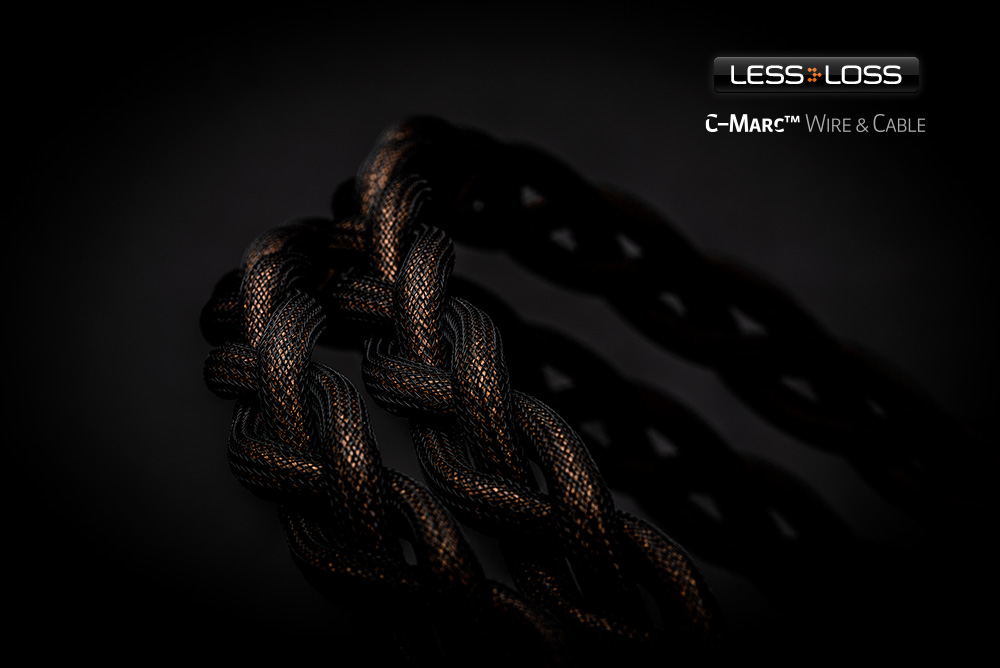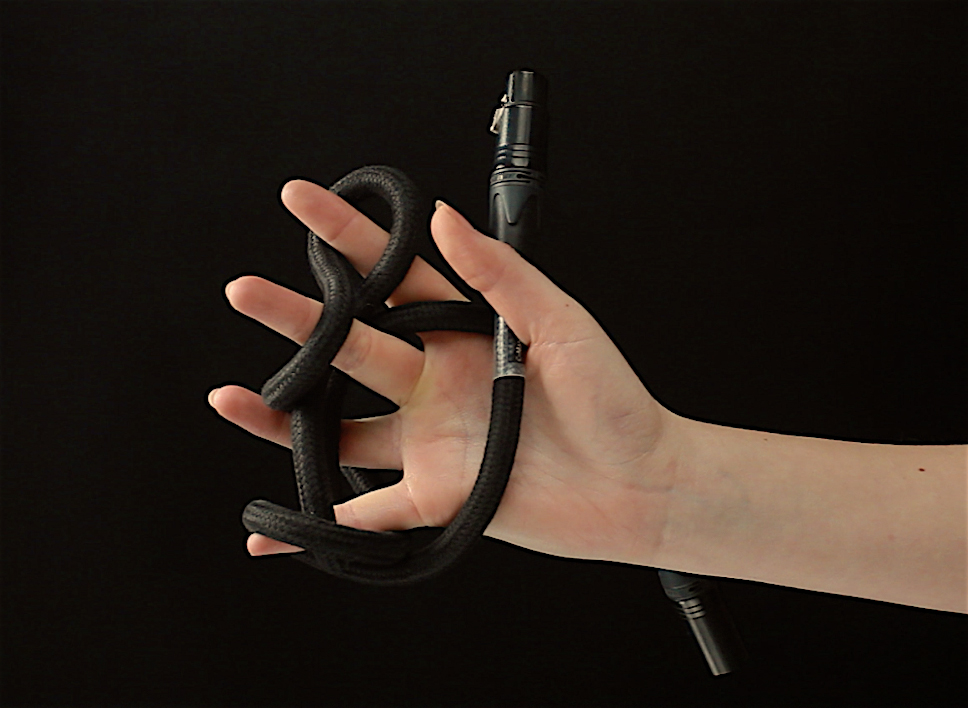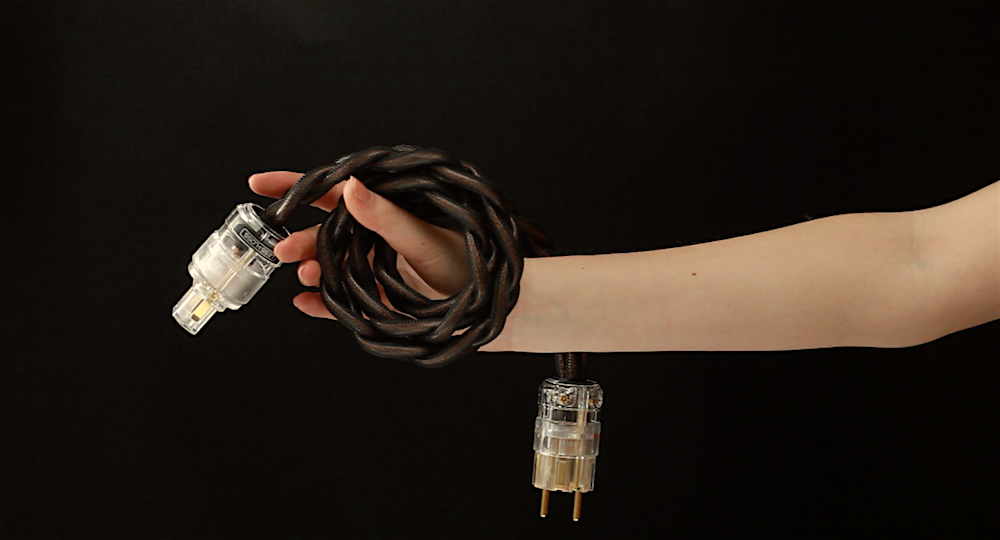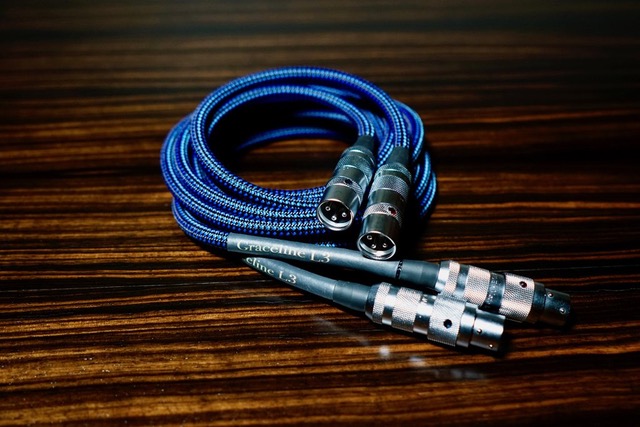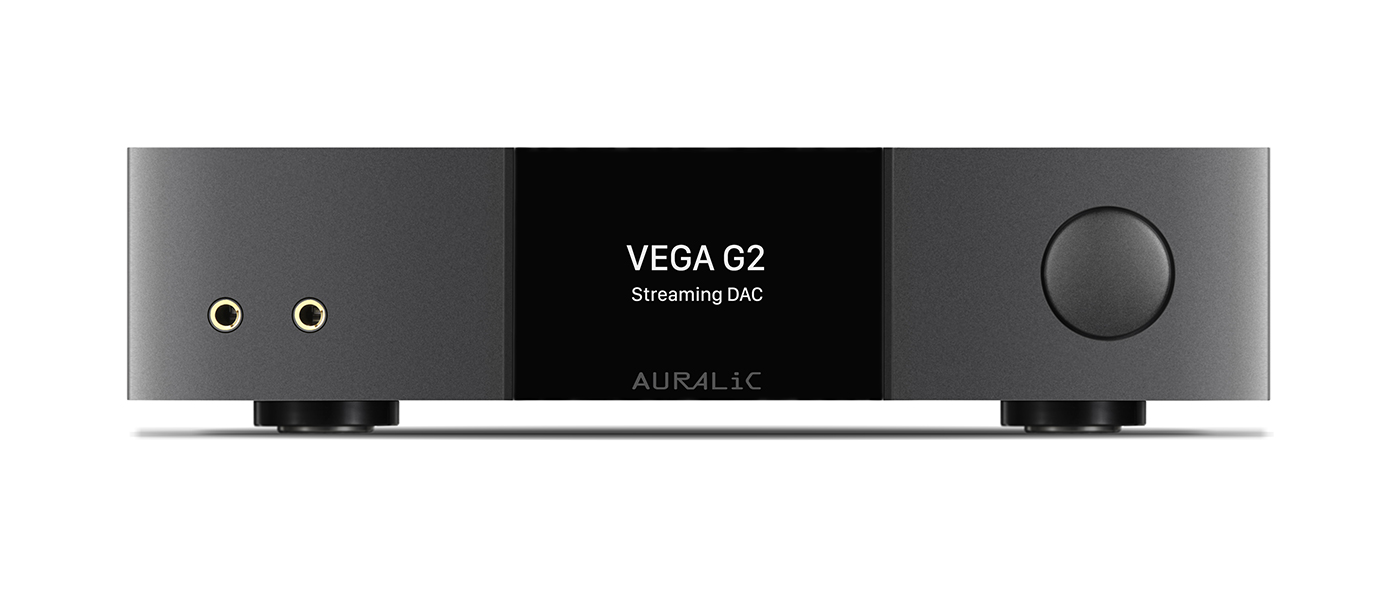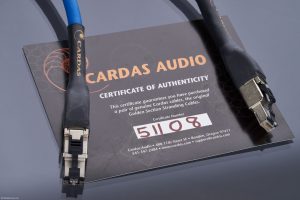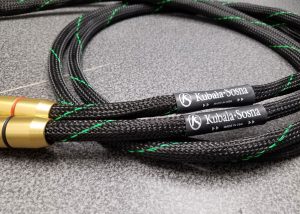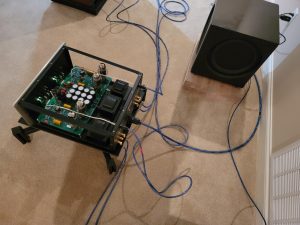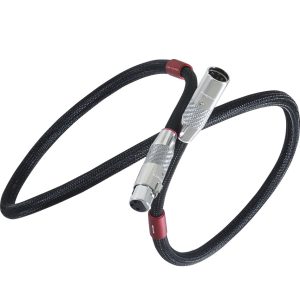The other day a friend of mine with keen ears, though not an audiophile, walked into my living room system and said "Hmmm… you changed something, I am hearing much more bass, more dynamic slam and less sizzle on top." Well then. Me, somewhat stumped as I was scratching my head trying to think of what I had changed, finally replied, "Oh, right, doh. I swapped the EINSTEIN OTL The Silver Bullet Mk II mono block power amp cables out, the EINSTEIN The Preamp power cable and the S/PDIF digital cable leashing my EINSTEIN The Last Record Player compact disc player to AURALiC's Vega G2." Indeed, while the rest of the system was still cabled with Nordost's Tyr 2 cables, said components had been wired up and nicely breaking in the all new Lessloss C-MARC cables. Since my preview of this set of cables HERE I've been genuinely impressed with Louis Motek's latest attempt at selling up his latest wares. Louis of course, has been quite busy lately—particularly his firewall technology seems to have caught the attention of his audience, and if production pictures he regularly posts are any indicator, sales seem to be brisk if not more than just brisk.
At $1148, sold direct (per 2 meter length; additional lengths available at very reasonable upgrade costs), just what exactly is this apparently great performing C-MARC cable? According to Lessloss.com, an otherwise rather well designed worldwide showroom, we find the following information straight from Louis: "C-MARC™ is a new type of Litz wire. C-MARC's noise reduction is based on the bucking coil method using two counter-polarized coils. Every strand's clock-wise turn aligns with a corresponding counter-clockwise turn of exactly mirrored diameter and step. The two resulting counter-polarized coils are mutually superposed. A second-scale fractal replication of the already bucking coils is then repeated. Through electrical cancellation of the induced noise, C-MARC™ provides an enormous signal-to-noise ratio in today's demanding environment." While I'm certainly no electronics engineer and therefore really can't comment one way or the other on the technical aspects of C-MARC, I can remark on the fact that among other things, however trivial it may seem, C-MARC counts as one of the best made and most flexible cable looms I have had in my system. Not even DFPC, C-MARC's rather terrific precursor, was this flexible and malleable, not to mention some other looms of cable I have been using, including Nordost.
Real world benefits of flexible cables, particularly of the power cable variety, have the benefit of being able to fit, or work, in places otherwise difficult to connect to; worse, some marquee super high-end cables are so bad in this regard that special care needs to be applied to just how you will be connecting your component to said power cable. Talk about fringe problems. Fortunately, I have had precisely zero issue with C-MARC, and in fact have found these cables to connect well and stay that way without any further thought. That Louis and team of artisans didn't stop there was clear from the first time that he mentioned this new [C-MARC] technology: "Danny, you will be shocked at just how much of an improvement these cables are compared to anything else we've seen." "Alright. I believe you!", I replied. Pondering the implication of this statement I immediately felt drawn to conclusions. Had it not been for my previous history and exposure to Louis and his wares, that conclusion might have swung exactly the opposite way. For as I was concerned, Louis never sprayed me with FUD, not once, ever. When, years ago, Louis approached me to spend time with his first DAC, the Lessloss model 2004, which he claimed to be revolutionary at the time, I didn't quite know where to park that exuberance. Months following extended listening sessions with that DAC, I quietly acquiesced. "Indeed", I recall saying to Louis during a phone call, "the 2004 is as you described. It fleshed out music far more than my previous reference without the nasty digitalitis so prevalent in DACs at that time." That interaction with Louis proved foundational for all others following.
Whenever Louis developed something new, as in the pre-pre-precursor to his Laminar Streamer as an example, ca. 2013-ish, the calls typically went the same. During one such visit at his former 27th floor downtown worldwide HQ overlooking the sad, infested gulag that is San Francisco, I was mightily impressed with that prototype. Though even calling it prototype was dubious as it really was no more than a box with lots of cables, capacitors and other some such things required for digital playback. Even here, Louis had made his definitive debonair mark: "Files undoubtedly sound best when read / played back via an SD card." No, not USB, not wired, not Ethernet, not any such standard. SD cards. Indeed, during A/B comparisons, the difference was not small. His Kaiser Kawero! Ioudspeakers handling sound transformation, the same file played back via SD card sounded more natural, more neutral, much more dynamic. In direct comparison, the transport sourced CD file sounded rather flat and dead. Having thus established and further confirmed Louis' street cred, I would have little to object to any of his future comments and outings.
Naturally, this level of obsessive, nay, fanatic orientation to the smallest of details—akin to Apple's steadfast orientation to their North Star—is also present in the C-MARC power cable loom (and S/PDIF cable) I had on hand. Even as you look at, for example, the choice of power cable connector, Lessloss filtered the very last bit of performance, no pun intended. Whereas DFPC used famed Oyaide connectors, C-MARC ditched this long term partner in favor of a clear, see-through type plastic connector. While on the face of it, that may not seem like a big deal, or more of an aesthetic design choice, the truth is anything but. Here again, Louis would opine that given C-MARCs striking superiority to any other cable geometry, including even DFPCs, the reasoning was rather simple: it sounded better. Have I mentioned Louis' fanatic attention to detail yet? Even on the S/PDIF cable, the cotton cable skin was chosen for its properties compared to other alternatives. So much for just the basics, we haven't even put these puppies through the proper DK ringer. To do the latter, I chose to supply plenty of break-in time with these component leashes. Not that it would have made hearing their immediate superiority any less obvious, even stone cold, swap for swap.
On a recent session through my new stash of records, including MoFi's latest One-Step Donald Fagen Nightfly, this at times lucid hobby of ours became more easily digested: with C-MARC in tow, Fagen's record sounded ever better. Better as in more full, dynamic, resolved; compared to my previous long-time reference of Tyr 2, C-MARC proved no less subtle in its effects even as it was just the power cables I had replaced. Clearly Louis' all new cable geometry formula was on to something. When I cued up MoFi's first One-Step album, Santana's Abraxas, the opening cut, "Singing Winds, Crying Beasts," sounded dramatically more open and rich as well; was it the added sense of depth? The more clearly defined wind chimes, with their superior sparkle and shine? The increased depth of the opening piano riff? My sensibly superior intuition not easily satisfied, I quickly disconnected C-MARC from reference system one and brought them over to system two: YG Sonja 2.3, grounded to EINSTEIN's The Preamp and The Poweramp. Interestingly, the increased resolution of C-MARC, made clear that the EINSTEIN OTLs where no longer part of this chain. Mind you, The Poweramp is no slouch and in fact shares much of the topology of the OTL amp and is easily one of the best amplifiers on the market. Yet, whereas the usual cadre of cables from Nordost, yes, even EINSTEIN's own, various Zu models and KS Emotion have a subtler effect on swapping the OTLs to The Poweramp, the change to C-MARC proved far more dramatic.
Information flow through the latest Lessloss generation seems greatly increased; where I wouldn't necessarily have called the previous DFPC generation constricted by any means, this latest cable series offers far greater dynamic range compared to what's currently in chez K. Further, that this comes at a modestly increased ever slightly higher price point compared to what was before, further demonstrates Lessloss' commitment to making this bridge seem smaller than it would appear otherwise. The typical high-end audio multiplier effect of at times dubious origins certainly doesn't seem to apply within the halls of Lessloss. How Louis and team do this whilst maintaining their superb quality and execution is possibly an illusionary magic act, though it appears that the company is indeed guided by actual, standardized principles in business acumen. Taking C-MARC's digital S/PDIF cable to task, the 1-meter length fronting a very reasonable price of $510 in RCA configuration, proves this point yet again and does so with spades in reserve. Sure, most everyone has moved from Compact Disc to compact streaming, myself included, though I often find myself—more so recently—asking why. Call it romancing that which was once noble and state of the art, call it reverence for nostalgia, the good old CD still has plenty to show for. Case in point, discovering and purchasing EINSTEIN's The Last Record Player, which aptly refers to the fact that this is all that you'll ever need to enjoy your prized silver discs, I have come to generally rediscover some of my discs again. Numbering around six hundred, maybe more, there's some genuine gems to be had, both old and new. Since embarking on my mission to catalog and digitize all of them some years ago using the painstaking single disc copy method via Poikosoft's Easy CDDA converter (sadly PC only), all of these discs are now safely stored on my QNAP 8-bay NAS totaling 32TB, though dual drive redundancy means an effective 22TB of raw data. Connected via my 4 eero mesh network WiFi routers, to a Roon Nucleus (review forthcoming), streaming to AURALiC's most amazing all new Vega G2 (also, review forthcoming), it has been a delight browsing through and slinging back and forth between this and that and the other sonic gem found in my collection.
Obviously a very different experience from putting on a record and generally listening through at least all of side A before switching. Perhaps it is this that I miss most when running the digital bonanza show. Perhaps it is the viewing of a physical medium in your hand, browsing through liner notes; or, perhaps, it is none of that and all this merely sits in your mind. Whatever the case may be, since adding the EINSTEIN disc player, which by the way plays Redbook CDs and nothing else, I have come to find myself enjoying disc after disc in much the same way as I have while listening to a record. My previous digital interlink super leash of choice was Black Cat's digital 75 Ohm variety. Made by the ever affable, now living in Japan, though soon to be returning to the US, Chris Sommovigo, Black Cat's digital link was the proverbial meow. Full, rich in tone and color, it was my go to link between the EINSTEIN and Vega G2. Leashed to Vega G2, C-MARC's own S/PDIF cable trumps Black Cat by a large margin. Not content with believing my own ears, I called my friend, you will recall him from the opening paragraph, and asked if he could come by for a quick listen. My bat eared non-audiophile audiophile encouragingly mumbled "Yes, you changed something; I am hearing a livelier and similarly more dynamic presentation from your EINSTEIN that wasn't there before. What did you change?" I suppose I could have left it at that but went on to explain that the critical link between The Last Record Player and AURALiC's Vega G2, said digital SPDIF cable, had been replaced with Lessloss C-MARC.
Let's check out one of my latest demo tracks, 2Raumwohnung's "Somebody Lonely And Me." Berlin's suave electro-pop duo, Inga Humpe and Tommi Eckhart, are a favorite of mine ever since their release of 2002's In Wirklich, heard by the way at Rocky Mountain Audiofest some years later. On their latest release, Nacht Und Tag Remixe, aforementioned "Somebody Lonely And Me" opens with a deeply satisfying, deeply pulsating beat, which opens up into some phase effect laden session around the 20 second mark followed by Inga's sensual, heavily processed vocal overdub. While playing this opening section through the Black Cat leash, you could easily make out the great bass lines, dynamics and otherwise well produced musical cues. That said, swapping leashes for C-MARC immediately revealed an ever-greater realization of this theme. Given C-MARC's claims of lowering distortion levels, lowering the noise floor to vanishing points, I'd say Lessloss has indeed lived up to its claims of providing the necessary magic. Bass lines in particular take on a vastly superior, vastly more powerful tone and impact. Think less syrup, more real flesh, meat and bone. A nice, lean cut of steak without A-1 steak sauce—salt and pepper only, medium rare. You still get the tonal flavors in all their richness, whilst adding the natural kick from a dash of salt and pepper. Said fondness for that type of sonic bliss adds value to chez K. Given the similar price point of the Lessloss leash, I'd take it over the Black Cat. Your mileage may vary.
Call it the Geist of Louis, call it by any other name, C-MARC is quite the upgrade. Now you might think that cables, power cables in particular, could not possibly have such a profound impact on sound; you may think that this is nothing more than balderdash; black magic. Fine. What matters in the end is that you perceive the benefit of said cable swap, nay, upgrade in your digs when you hit play. That is something only can decide on—I for one have been smitten with Louis Motek wares for some time. While at first he may seem like a mad scientist, you quickly discover that he's a genuine cable scientist, period. My time with Lessloss C-MARC has proven once again that you don't have to spend gobs of money on cables to get reference level sound. Mind you, yet again, this review was built around power cables and a digital S/PDIF leash only. Louis has speaker cables and interconnects too—could the cumulative effect add even more value to your sound? Likely. I've seen that with Kubala-Sosna in particular. Outside of cables, Lessloss has also gone down the road of filter boxes and firewalls. Curiously considering such add-ons, you'll find reviewers smitten beyond the initial meow. What's next for chez K's Lessloss stable is anyone's guess, though it appears that more could be lurking down the path. Given that Louis has been in business for some time, enjoys very high reputation among genuine industry insiders, read: no BS folks, this makes a recommendation rather easy. I'm willing to bet they'll end up as keepers. Mine did! A+++
C-MARC S/PDIF cable
Retail: $695
C-MARC Power Cord
Retail: From $1148
Lessloss




